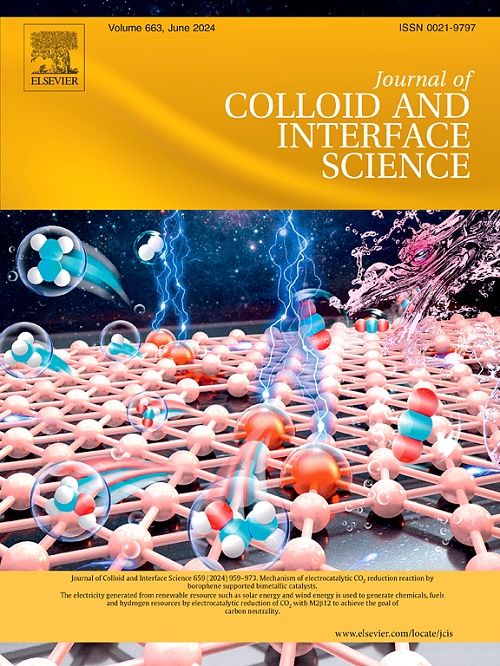沸石咪唑酸框架-67纳米反应器对二氧化碳还原和六价铬固定化的形貌依赖性
IF 9.4
1区 化学
Q1 CHEMISTRY, PHYSICAL
引用次数: 0
摘要
能源转化和污染物修复是环境保护的重要手段。沸石咪唑酸框架-67 (ZIF-67)是一种理想的催化剂。在这项研究中,合成了四种形态的ZIF-67,用于光催化二氧化碳(CO2)的转化和六价铬(Cr(VI))的吸附。在光照射下,ZIF-67 (ZIF-R)可将二氧化碳转化为一氧化碳(CO)和甲烷(CH4),产率分别为1182.62和27.21 μmol g−1 h−1。此外,通过综合实验考察了反应时间、pH、起始浓度、共存离子和温度的影响,并进行了相应的动力学和热力学分析。结果表明,ZIF-R对Cr(VI)具有良好的吸附能力(46.87 mg g−1)。经过四个循环的吸附和光催化实验,ZIF-R保持了良好的可重复使用性。因此,ZIF-R是一种高效的光催化剂和稳定的吸附剂,为减少温室气体排放和去除环境污染物提供了有前途的解决方案。本文章由计算机程序翻译,如有差异,请以英文原文为准。

Morphology dependence of zeolitic imidazolate framework-67 nanoreactor for carbon dioxide reduction and hexavalent chromium immobilisation
Energy conversion and pollutant remediation are essential means of environmental protection. Zeolitic imidazolate framework-67 (ZIF-67) is an ideal catalyst for these processes. In this study, four morphologies of ZIF-67 were synthesised for the photocatalytic conversion of carbon dioxide (CO2) and adsorption of hexavalent chromium (Cr(VI)). Under light irradiation, rhombic ZIF-67 (ZIF-R) converted carbon dioxide to carbon monoxide (CO) and methane (CH4), with production rates of 1182.62 and 27.21 μmol g−1 h−1, respectively. Furthermore, comprehensive experiments were conducted to examine the effects of reaction duration, pH, starting concentration, coexisting ions and temperature, along with corresponding kinetic and thermodynamic analyses. Results demonstrated that ZIF-R exhibited outstanding Cr(VI) adsorption capacity (46.87 mg g−1). After four cycles of adsorption and photocatalytic experiments, ZIF-R maintained excellent reusability. Thus, ZIF-R is an efficient photocatalyst and stable adsorbent, offering a promising solution for mitigating greenhouse gas emissions and removing environmental pollutants.
求助全文
通过发布文献求助,成功后即可免费获取论文全文。
去求助
来源期刊
CiteScore
16.10
自引率
7.10%
发文量
2568
审稿时长
2 months
期刊介绍:
The Journal of Colloid and Interface Science publishes original research findings on the fundamental principles of colloid and interface science, as well as innovative applications in various fields. The criteria for publication include impact, quality, novelty, and originality.
Emphasis:
The journal emphasizes fundamental scientific innovation within the following categories:
A.Colloidal Materials and Nanomaterials
B.Soft Colloidal and Self-Assembly Systems
C.Adsorption, Catalysis, and Electrochemistry
D.Interfacial Processes, Capillarity, and Wetting
E.Biomaterials and Nanomedicine
F.Energy Conversion and Storage, and Environmental Technologies

 求助内容:
求助内容: 应助结果提醒方式:
应助结果提醒方式:


